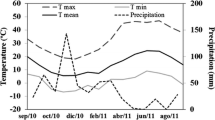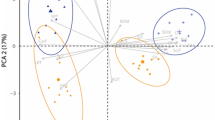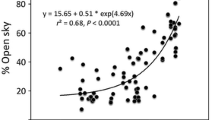Abstract
Exploitation of patchy light is a key determinant of plant performance in the forest understory. While many adaptive traits are known, the role of stem vasculature in understory photosynthesis is not established. Sectoriality—the degree of vascular constraint to long distance transport—has been hypothesized to limit growth in heterogeneous light. We simulated the photosynthetic potential of sectored and integrated plants in patchy light, as a function of soil water potential (patchy or uniform). We used hydraulic parameters typical of temperate woody species in an Ohm’s law model including a tangential resistance parameter, and simulated cavitation by varying axial resistance of leaves, leaves and roots, or the whole plant. Our results suggest that differential sectoriality will not affect photosynthesis when water is plentiful, but can constrain stomatal conductance at more negative soil water potentials, especially when only a small portion of the crown receives light. This effect is strongest just below the turgor loss point, and depends on axial resistance and soil water heterogeneity. Increased resistance in high light leaves decreases photosynthesis regardless of sectoriality. However, when resistance is increased for leaves and roots or the whole plant, photosynthesis decreases more for sectored than for integrated plants. Moreover, the simulations suggest that sectoriality can further depress photosynthesis when water availability is asymmetrical. These results might explain why integrated species, such as Betula lenta, B. alleghaniensis, and Acer saccharum thrive in the forest understory and grow rapidly into canopy gaps, while sectored species, such as Quercus rubra, do not.







Similar content being viewed by others
References
Breshears DD, Rich PM, Barnes FJ, Campbell K (1997) Overstory-imposed heterogeneity in solar radiation and soil moisture in a semiarid woodland. Ecol Appl 7:1201–1215
Caldwell MM, Dawson TE, Richards JH (1998) Hydraulic lift: consequences of water efflux from the roots of plants. Oecologia 113:151–161
Canham CD (1985) Suppression and release during canopy recruitment in Acer saccharum. Bull Torrey Bot Club 112:134–145
Choat B, Cobb AR, Jansen S (2007) Structure and function of bordered pits: new discoveries and impacts on whole plant hydraulic function. New Phytol 177:608–626
Collatz GJ, Ball JT, Grivet C, Berry JA (1991) Physiological and environmental regulation of stomatal conductance, photosynthesis and transpiration: a model that includes a laminar boundary layer. Agric For Meteorol 54:107–136
Davis SD, Sperry JS, Hacke UG (1999) The relationship between xylem conduit diameter and cavitation caused by freezing. Am J Bot 86:1367–1372
Ellmore GS, Zanne AE, Orians CM (2006) Comparative sectoriality in temperate hardwoods: hydraulics and xylem anatomy. Bot J Linn Soc 150:61–71
Gloser V, Libera K, Orians CM (2008) Contrasting below- and aboveground responses of two deciduous trees to patchy nitrate availability. Tree Physiol 28:37–44
Greenidge KNH (1955) Studies in the physiology of forest trees. III. The effect of drastic interruption of conducting tissues on moisture movement. Am J Bot 42:582–587
Hacke UG, Stiller V, Sperry JS, Pittermann J, McCulloh KA (2001) Cavitation fatigue: embolism and refilling cycles can weaken the cavitation resistance of xylem. Plant Physiol 125:779–786
Hacke UG, Sperry JS, Wheeler JK, Castro L (2006) Scaling of angiosperm xylem structure with safety and efficiency. Tree Physiol 26:689
Jones TJ, Luton CD, Santiago LS, Goldstein G (2010) Hydraulic constraints on photosynthesis in subtropical evergreen broad leaf forest and pine woodland trees of the Florida Everglades. Trees Struct Funct 24:471–478
Kitin PB, Fujii T, Abe H, Funada R (2004) Anatomy of the vessel network within and between tree rings of Fraxinus lanuginosa (Oleaceae). Am J Bot 91:779–788
Knapp AK (1992) Leaf gas exchange in Quercus macrocarpa (Fagaceae): rapid stomatal responses to variability in sunlight in a tree growth form. Am J Bot 79:599–604
Kobe RK, Pacala SW, Silander JA, Canham CD (1995) Juvenile tree survivorship as a component of shade tolerance. Ecol Appl 5:517–532
Kozlowski TT, Winget CH (1963) Patterns of water movement in forest trees. Bot Gaz 124:301–311
Loepfe L, Martinez-Vilalta J, Pinol J, Mencuccini M (2007) The relevance of xylem network structure for plant hydraulic efficiency and safety. J Theor Biol 247:788–803
Mackay JFG, Weatherly PE (1973) The effects of transverse cuts through the stems of transpiring woody plants on water transport and stress in the leaves. J Exp Bot 24:15–28
Nadezhdina N (2010) Integration of water transport pathways in a maple tree: responses of sap flow to branch severing. Ann For Sci 67:107
Nardini A, Salleo S (2000) Limitation of stomatal conductance by hydraulic traits: sensing or preventing xylem cavitation? Trees Struct Funct 15:14–24
Niinemets Ü, Valladares F (2006) Tolerance to shade, drought, and waterlogging of temperate Northern Hemisphere trees and shrubs. Ecol Monographs 76:521–547
Nowacki GJ, Abrams MD (1997) Radial-growth averaging criteria for reconstructing disturbance histories from presettlement-origin oaks. Ecol Monographs 67:225–249
Orians CM, van Vuuren MMI, Harris NL, Babst BA, Ellmore GS (2004) Differential sectoriality in long-distance transport in temperate tree species: evidence from dye flow, 15N transport, and vessel element pitting. Trees Struct Funct 18:501–509
Orians CM, Smith SDP, Sack L (2005) How are leaves plumbed inside a branch? Differences in leaf-to-leaf hydraulic sectoriality among six temperate tree species. J Exp Bot 56:2267–2273
Pearcy RW, Gross LJ, He D (1997) An improved dynamic model of photosynthesis for estimation of carbon gain in sunfleck light regimes. Plant Cell Environ 20:411–424
Postlethwait SN, Rogers B (1958) Tracing the path of the transpiration stream in trees by the use of radioactive isotopes. Am J Bot 45:753–757
Preston KA (1998) The effects of developmental stage and source leaf position on integration and sectorial patterns of carbohydrate movement in an annual plant, Perilla frutescens (Lamiaceae). Am J Bot 85:1695–1703
Sack L, Cowan PD, Jaikumar N, Holbrook NM (2003) The ‘hydrology’ of leaves: co-ordination of structure and function in temperate woody species. Plant Cell Environ 26:1343–1356
Schenk HJ, Espino S, Goedhart CM, Nordenstahl M, Cabrera HIM, Jones CS (2008) Hydraulic integration and shrub growth form linked across continental aridity gradients. Proc Natl Acad Sci USA 105:11248–11253
Schulte PJ, Costa DC (2010) Xylem anisotropy and water transport—a model for the doule sawcut experiment. Tree Physiol 30:901–913
Singsaas EL, Ort DR, DeLucia EH (2000) Diurnal regulation of photosynthesis in understory saplings. New Phytol 145:39–49
Sperry JS, Alder NN, Eastlack SE (1993) The effect of reduced hydraulic conductance on stomatal conductance and xylem cavitation. J Exp Bot 44:1075–1082
Stark JM (1994) Causes of soil nutrient heterogeneity at different scales. In: Caldwell MM, Percy RW (eds) Exploitation of environmental heterogeneity by plants. Academic Press, San Diego, pp 255–284
Steppe K, Cnudde V, Girard C, Lemeur R, Cnudde JP, Jacobs P (2004) Use of X-ray computed microtomography for non-invasive determination of wood anatomical characteristics. J Struct Biol 148:11–21
Thornley JH, Johnson IR (2000) Plant and crop modelling: a mathematical approach to plant and crop physiology. Blackburn Press Caldwell, New Jersey
Tyree MT, Ewers FW (1991) Tansley Review No. 34. The hydraulic architecture of trees and other woody plants. New Phytol 119:345–360
Tyree MT, Zimmerman MH (2002) Xylem structure and the ascent of sap. Springer, Berlin
Watson MA, Casper BB (1984) Morphogenetic constraints on patterns of carbon distribution in plants. Annu Rev Ecol Systematics 15:233–258
Webster CR, Jensen NR (2007) A shift in the gap dynamics of Betula alleghaniensis in response to single-tree selection. Can J For Res 37:682–689
West GB, Brown JH, Enquist BJ (1999) A general model for the structure and allometry of plant vascular systems. Nature 400:664–667
Yang Z, Midmore DJ (2005) Modelling plant resource allocation and growth partitioning in response to environmental heterogeneity. Ecol Model 181:59–77
Zanne AE, Sweeney K, Sharma M, Orians CM (2006) Patterns and consequences of differential vascular sectoriality in 18 temperate tree and shrub species. Funct Ecol 20:200–206
Zanne AE, Westoby M, Falster DS, Ackerly DD, Loarie SR, Arnold SEJ, Coomes DA (2010) Angiosperm wood structure: Global patterns in vessel anatomy and their relation to wood density and potential conductivity. Am J Bot 97:207–215
Zwieniecki MA, Orians CM, Melcher PJ, Holbrook NM (2003) Ionic control of the lateral exchange of water between vascular bundles in tomato. J Exp Bot 54:1399–1405
Acknowledgments
We would like to thank the Tufts University Department of Biology for financial and logistical support, Dr. Lawren Sack for advice on the modeling of leaf hydraulics, Dr. Amy Zanne for assistance relating the literature on vessel anatomy to sectoriality, and Dr. George Ellmore and Dr. Nathan Phillips for their comments on previous drafts.
Author information
Authors and Affiliations
Corresponding author
Additional information
Communicated by M. Zwieniecki.
Electronic supplementary material
Below is the link to the electronic supplementary material.
Rights and permissions
About this article
Cite this article
Thorn, A.M., Orians, C.M. Modeling the influence of differential sectoriality on the photosynthetic responses of understory saplings to patchy light and water availability. Trees 25, 833–845 (2011). https://doi.org/10.1007/s00468-011-0559-5
Received:
Revised:
Accepted:
Published:
Issue Date:
DOI: https://doi.org/10.1007/s00468-011-0559-5




